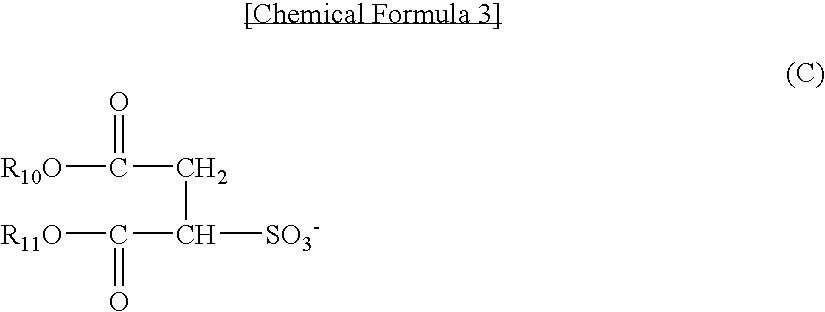Biodegradable Resin Composition
- Summary
- Abstract
- Description
- Claims
- Application Information
AI Technical Summary
Benefits of technology
Problems solved by technology
Method used
Image
Examples
examples
[0085] The present invention will be illustrated in further detail with reference to several examples below, which by no means limit the scope of the present invention.
examples 12 to 20
[0090] A series of resin compositions were prepared by subjecting poly(lactic acid) resin (LACEA H-100; available from Mitsui Chemicals, Inc.), any of the surfactants (1) to (3) for use in the present invention, and a compatibilizer in the proportions in Table 2 to melting and kneading in a twin-screw kneading extruder at a die temperature of 160° C. The resulting resin compositions were taken as Examples 12 to 20.
example 21-1
T-Die Extrusion
[0121] Pellets were prepared by melting and kneading a poly(lactic acid) [LACEA H-400 (trade name of the product of Mitsui Chemicals, Inc.)] and 10% by weight of a 25:75 (percent by weight) mixture of Surfactant (1) and the reaction product between boric acid and glycerol monostearate as a compatibilizer. The poly(lactic acid) H-400 as a biodegradable resin (10 kg) and the pellets (0.5 kg) were dry-blended and were molded into a sheet at a melting temperature of 210° C. to 230° C. using a T-die extruder equipped with a dehumidification dryer. The sheet has a thickness of 200 μm, a molecular weight retention of 96.8%, a specific surface resistance of 12.3 and a half-life of 10 seconds. Next, the sheet was heated in an oven at set temperatures of 70° C. to 75° C. for one minute, was stretched 3.0 times in vertical direction and 3.0 times in crosswise direction, and was heated to 150° C., followed by heat setting at 150° C. for one minute. The resulting film has a thick...
PUM
| Property | Measurement | Unit |
|---|---|---|
| Percent by mass | aaaaa | aaaaa |
| Fraction | aaaaa | aaaaa |
| Fraction | aaaaa | aaaaa |
Abstract
Description
Claims
Application Information
 Login to View More
Login to View More - R&D
- Intellectual Property
- Life Sciences
- Materials
- Tech Scout
- Unparalleled Data Quality
- Higher Quality Content
- 60% Fewer Hallucinations
Browse by: Latest US Patents, China's latest patents, Technical Efficacy Thesaurus, Application Domain, Technology Topic, Popular Technical Reports.
© 2025 PatSnap. All rights reserved.Legal|Privacy policy|Modern Slavery Act Transparency Statement|Sitemap|About US| Contact US: help@patsnap.com



